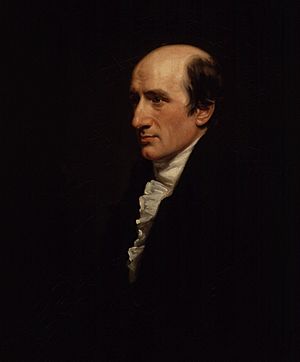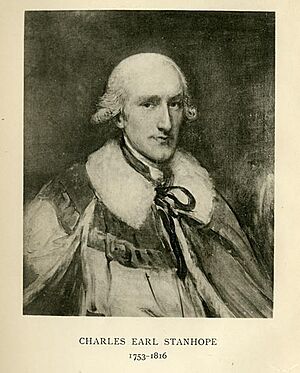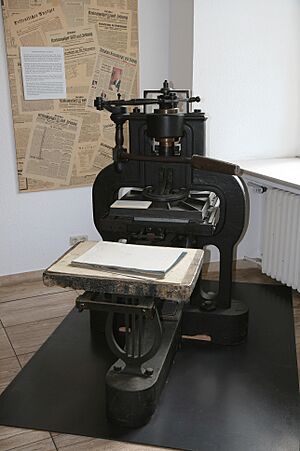Charles Stanhope, 3rd Earl Stanhope facts for kids
Quick facts for kids
The Earl Stanhope
|
|
|---|---|

Portrait of Earl Stanhope by John Opie
|
|
| Member of Parliament for Wycombe with Robert Waller |
|
| In office 18 October 1780 – 1786 |
|
| Preceded by | Thomas FitzMaurice |
| Succeeded by | Earl Wycombe |
| Personal details | |
| Born | 3 August 1753 |
| Died | 15 December 1816 (aged 63) |
| Political party | Whig |
| Spouses | Lady Hester Pitt Louisa Grenville |
| Children | 6 |
| Parents | Philip Stanhope, 2nd Earl Stanhope Grizel Hamilton |
Charles Stanhope, 3rd Earl Stanhope (born August 3, 1753 – died December 15, 1816), was an important British statesman, a clever inventor, and a dedicated scientist. He was also known as Charles Mahon. He was the father of Lady Hester Stanhope and the brother-in-law of William Pitt the Younger, who was a famous Prime Minister.
Contents
Early Life and Education
Charles Stanhope was the son of Philip Stanhope, 2nd Earl Stanhope. He went to school at Eton, a well-known school in England. Later, he studied at the University of Geneva in Switzerland. While in Geneva, he spent a lot of time studying mathematics with his teacher, Georges-Louis Le Sage. His time in Switzerland also gave him a strong belief in freedom and liberty.
Political Career
In politics, Charles Stanhope believed in democracy, meaning he thought people should have a say in their government. When he was just old enough, he tried to become a Member of Parliament (MP) for Westminster in 1774, but he didn't win.
However, from 1780 to 1786, he represented the area of High Wycombe in Parliament. During this time, he supported William Pitt the Younger. Charles Stanhope even married Pitt's sister, Lady Hester Pitt, in 1774.
As time went on, Pitt's political ideas changed. Charles Stanhope disagreed with some of the government's strong actions. Because of this, he stopped supporting Pitt and became an opponent. Lord Stanhope was known for being fair and sticking to his beliefs.
He was also the leader of the "Revolution Society." This group celebrated the Glorious Revolution of 1688 in Britain. In 1790, the society showed support for the goals of the French Revolution. In 1794, Stanhope supported Thomas Muir, a politician who was sent away to Australia for his views. In 1795, he tried to pass a motion in the House of Lords that said Britain should not interfere with France's internal affairs. He was the only one to vote for this, earning him the nickname "minority of one." After this, he left Parliament for five years.
Science, Inventions, and Writings
Charles Stanhope was a very talented scientist and inventor. His interest in science began at the University of Geneva where he studied mathematics. He also studied electricity and wrote a book called Principles of Electricity in 1779. In this book, he shared his ideas about how lightning's electric current interacts with the earth.
He became a member of the Royal Society in 1772, which is a famous group for scientists. He spent a lot of his money on scientific experiments. He invented many things, including:
- A way to protect buildings from fire (though it didn't work well in practice).
- The first iron printing press, which made printing faster and better.
- A method to create metal printing plates from plaster molds, called stereotype plates.
- The Stanhope lens, a special type of lens.
- A monochord for tuning musical instruments.
- Improvements for canal locks.
- Experiments with steam-powered boats between 1795 and 1797.
- Two calculating machines, the first one in 1775.
He was also a member of the American Philosophical Society, joining in 1774, and the American Antiquarian Society in 1816.
When he owned a lot of land in Devon, he planned to build a canal through the county, connecting the Bristol to the English Channel. He even surveyed the land himself.
He also wrote several books. These included a response to Edmund Burke's Reflections on the French Revolution (1790) and an Essay about the rights of juries (1792). He also thought about creating a complete collection of laws.
Family Life
Charles Stanhope was married twice. His first marriage was on December 19, 1774, to Lady Hester Pitt. She was the daughter of William Pitt, 1st Earl of Chatham, who was a Prime Minister. They had three daughters:
- Lady Hester Lucy Stanhope (1776–1839) became a famous traveler and expert on Arab culture. She never married.
- Lady Griselda Stanhope (1778–1851).
- Lady Lucy Rachel Stanhope (1780–1814).
His second marriage was in 1781 to Louisa Grenville. She was the daughter of the Hon. Henry Grenville. They had three sons:
- Philip Henry Stanhope, 4th Earl Stanhope (1781–1855), who became the next Earl. He also had an interest in science, like his father.
- Major Hon. Charles Banks Stanhope (1785–1809), who was a military officer and was killed in battle.
- Lieutenant Colonel Hon. James Hamilton Stanhope (1788–1825), who was also a military officer.
Death
Lord Stanhope passed away at his family home, Chevening, in Kent. His eldest son, Philip Henry Stanhope, inherited his title and continued his father's scientific interests. A monument to Charles Stanhope was created by Josephus Pinnix Kendrick at Chevening.
Images for kids
-
Portrait of Earl Stanhope by John Opie






